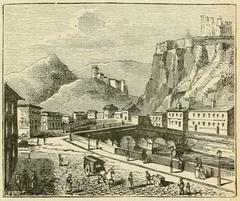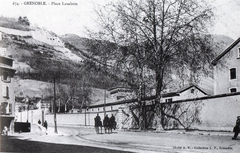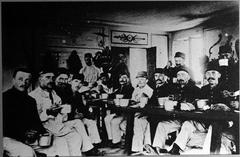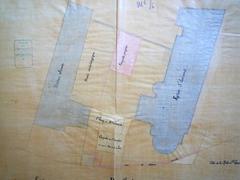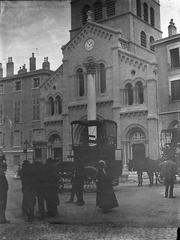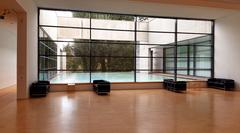
Saint Roch Cemetery Grenoble Visiting Hours, Tickets, and Historical Sites Guide
Date: 03/07/2025
Introduction: Discover the Legacy of Saint Roch Cemetery in Grenoble
Saint Roch Cemetery (Cimetière Saint-Roch) in Grenoble, France, is much more than a burial ground—it is a living archive and open-air museum reflecting the city’s historical, cultural, and artistic heritage. Established in 1810 as Grenoble’s first municipal cemetery, it marked a pivotal shift from church-affiliated burials to inclusive, secular spaces open to all citizens, regardless of faith or social status (grenoble-patrimoine.fr). Its strategic location in the Île-Verte district, along the Isère River, addressed both public health concerns and the need for larger burial spaces during the post-Revolution Napoleonic era.
Today, Saint Roch Cemetery spans 13 hectares, housing approximately 25,000 to 29,000 graves, and offers a unique blend of tranquil green spaces, architectural grandeur, and rich funerary art. Its avenues, mausoleums, and monuments showcase a diversity of styles—from neoclassical to Art Nouveau—reflecting the evolving artistic and social history of Grenoble (saintrochgrenoble.fr). Whether you are a history enthusiast, art lover, or simply seeking a peaceful urban retreat, Saint Roch Cemetery is a must-visit site in Grenoble.
Table of Contents
- Origins and Evolution of Saint Roch Cemetery
- Architectural Highlights and Artistic Heritage
- Social and Cultural Significance
- Notable Graves and Monuments
- Preservation, Guided Tours, and Digital Innovation
- Practical Visitor Information
- Nearby Attractions
- Frequently Asked Questions (FAQ)
- Conclusion: Plan Your Visit
- References
Origins and Evolution of Saint Roch Cemetery
Saint Roch Cemetery was inaugurated in 1810 as Grenoble’s first municipal cemetery open to all, representing a significant transformation in French burial practices. Its establishment followed the 1804 Napoleonic Code, which mandated municipal cemeteries separate from churches and allowed for private, long-term, or perpetual burial plots (grenoble-patrimoine.fr).
Originally situated outside the city’s fortifications in the Île-Verte district, the cemetery’s location provided ample space for expansion and helped address health concerns associated with inner-city burials. Its name derives from a nearby ancient chapel, further embedding it in the local religious and historical landscape.
Over the years, Saint Roch Cemetery has expanded and adapted to Grenoble’s growing population, all while preserving its original church-inspired layout, marked by a central boulevard culminating in a neoclassical chapel.
Architectural Highlights and Artistic Heritage
Saint Roch Cemetery is renowned for its harmonious blend of landscape and funerary art:
- Design and Layout: The cemetery’s avenues are lined with trees and feature park-like landscaping, making it a peaceful, reflective space. The original plan, reminiscent of ecclesiastical architecture, is still visible in the geometric arrangement of its oldest sections.
- Chapel of Saint Roch: Built in 1826, this neoclassical chapel stands as the cemetery’s spiritual and visual centerpiece, replacing a 15th-century chapel once linked to a plague hospital.
- Funerary Art: Over 800 tombs are classified as “remarkable” for their artistic or historical value. Visitors can admire a spectrum of styles—neoclassical, Gothic Revival, Art Nouveau, and Art Deco—crafted from local stone, marble, granite, and cast iron.
- Monumental Mausoleums: Notable are the grand family mausoleums, especially those of glove manufacturers who shaped Grenoble’s 19th- and early 20th-century economy.
- Renowned Sculptors: Several acclaimed local sculptors—Victor Sappey, Henri Ding, Eustache Bernard, Aimé Charles Irvoy, and Urbain Basset—are both buried here and represented by their artistic works on-site.
Social and Cultural Significance
Saint Roch Cemetery is a “museum in the open air,” encapsulating Grenoble’s changing attitudes towards death, memory, and civic identity. Family tombs range from humble to elaborate, often adorned with poetic epitaphs, religious iconography, or symbols of professions and honors. The site is also a focal point for collective remembrance, with monuments dedicated to war victims, epidemic casualties, and prominent citizens (saintrochgrenoble.fr).
A particularly poignant area is the military square (carré militaire), which contains 136 graves of soldiers from World War I and II, underscoring Grenoble’s role in national defense (Geneanet).
Annual ceremonies such as Armistice Day and All Saints’ Day bring families, veterans, and officials together, reinforcing the cemetery’s central place in Grenoble’s civic life.
Notable Graves and Monuments
Saint Roch Cemetery is the final resting place of many distinguished figures:
- Michel Lotito (“Monsieur Mangetout”): The famous showman known for eating metal and glass, including a small airplane, is buried here. His grave continues to attract curious visitors (Kiddle).
- Military Heroes: The military square honors decorated officers and resistance fighters, symbolizing the city’s wartime sacrifices.
- Artists, Dignitaries, and Intellectuals: Graves of painters like Jules Flandrin and Jean Achard, and several past mayors and sculptors, are marked by unique monuments and artistic details.
- Family Mausoleums: Many grand tombs commemorate Grenoble’s industrialists and glove manufacturers, reflecting the city’s economic heritage.
Preservation, Guided Tours, and Digital Innovation
Saint Roch Cemetery remains an active burial site while embracing heritage preservation. Local associations such as “Saint Roch, vous avez dit cimetière?” work with the municipality to organize guided tours, educational projects, and art events.
A notable digital innovation is the virtual interactive tour, created in partnership with the Grenoble-based startup UBILINK. This allows visitors to explore 11 heritage tombs in the “Carré 1870” section through a digital avatar named Camille, making the cemetery’s stories accessible to remote audiences (grenoble.fr).
Practical Visitor Information
Visiting Hours
- Summer (March 1 – November 1): 7:30 AM – 6:30 PM
- Winter (November 2 – February 28): 7:30 AM – 5:30 PM
- Sundays & Public Holidays:
- Summer: 9:00 AM – 6:30 PM
- Winter: 9:00 AM – 5:30 PM
Admission and Tickets
- Entry: Free for all visitors. No tickets required for individual visits.
- Guided Tours: Typically require tickets (4–7 euros). Book in advance via the local association or Tourist Office.
Accessibility
- Vehicle Access: Monday–Saturday, 7:30 AM–10:30 AM, for visitors with a medical certificate or disability card.
- Pathways: Main avenues are paved and mostly accessible, though some historic sections may have uneven ground.
- Facilities: Restrooms are minimal; bring water and plan ahead, especially in warmer months.
Guided Tours and Virtual Experiences
- In-Person Tours: Offered by “Saint Roch, vous avez dit cimetière?”, with thematic focuses on art, history, or notable figures. English-language tours available by arrangement.
- Virtual Tour: Digital exploration of heritage tombs via the city’s website.
Travel Tips
- Best Time to Visit: Early morning or late afternoon for peaceful walks and optimal photography lighting.
- Footwear: Wear comfortable shoes to navigate the cemetery’s extensive paths.
- Maps: Download or pick up a map from the Tourist Office or the official website.
Location and Transport
- Address: 2 rue du Souvenir, 38000 Grenoble, France
- Public Transport: Bus lines 13 and 16 (stop “Saint-Roch”), tram line B (stop “Île Verte”).
- Parking: Limited—public transport is recommended.
Nearby Attractions
Enhance your visit by exploring these nearby Grenoble landmarks:
- Bastille Fortress: Panoramic city and Alpine views.
- Saint-Laurent District: Historic architecture and lively streets.
- Musée de Grenoble: Fine arts and contemporary exhibitions.
- Jardin de Ville: Urban green space in central Grenoble.
For more visitor recommendations, see the Lodgis Grenoble Visitor Guide and try-travel.com.
Frequently Asked Questions (FAQ)
Q: What are the opening hours of Saint Roch Cemetery?
A: Generally 7:30 AM–6:30 PM in summer, 7:30 AM–5:30 PM in winter. Sundays and holidays may have later opening times.
Q: Is there an entry fee?
A: No, individual entry is free. Special tours or events may require tickets.
Q: Are guided tours available in English?
A: Yes, with advance booking through the association or Tourist Office.
Q: Is the cemetery wheelchair accessible?
A: Main paths are accessible, though some older sections may be uneven. Vehicle access is available for those with disabilities during specified hours.
Q: Can I visit at night?
A: No, the cemetery is closed after official hours for safety and preservation.
Q: Where can I find maps or virtual tours?
A: Maps are available at the entrance and online. Explore the virtual tour at Grenoble’s official site.
Conclusion: Plan Your Visit to Saint Roch Cemetery
Saint Roch Cemetery is a profound testament to Grenoble’s enduring history, social evolution, and artistic achievement. With free admission, accessible pathways, and enriching guided or virtual tours, it welcomes a diverse audience—from historians and genealogists to casual visitors and photographers. The cemetery’s tranquil setting, monumental artistry, and proximity to other key city attractions make it a cornerstone of cultural tourism in Grenoble.
For the best experience, plan your visit using the official resources, join a guided tour for in-depth insights, and consider downloading the Audiala app for audio guides and event updates. Respect the solemnity of the site and immerse yourself in the stories etched in stone.
References and Official Resources
- Grenoble Patrimoine – Cimetière Saint-Roch
- Saint Roch Grenoble Official Website
- Grenoble City – Saint Roch Cemetery
- Lodgis Grenoble Visitor Guide
- Geneanet: Saint Roch Military Square
- Kiddle: Michel Lotito Biography
- Grenoble Tourist Office Opening Hours
- Try Travel: Things to Do in Grenoble
For a richer experience, explore images and interactive maps of Saint Roch Cemetery with descriptive alt text such as “Saint Roch Cemetery main boulevard in Grenoble” or “Funerary art Saint Roch Cemetery,” enhancing both accessibility and search engine optimization.









